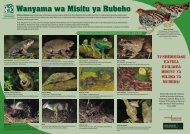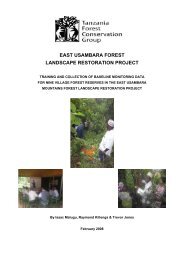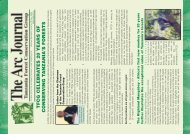Assessment of the biological values of different land cover types in ...
Assessment of the biological values of different land cover types in ...
Assessment of the biological values of different land cover types in ...
Create successful ePaper yourself
Turn your PDF publications into a flip-book with our unique Google optimized e-Paper software.
6) Resource use survey<br />
6.1 Introduction<br />
Most local communities <strong>in</strong> rural Tanzania depend on natural resources to support <strong>the</strong>ir livelihoods. In <strong>the</strong> East<br />
Usambara Mounta<strong>in</strong>s, <strong>the</strong> forest resources used most frequently by <strong>the</strong> local people <strong>in</strong>clude fuelwood, timber,<br />
poles, medic<strong>in</strong>al plants and food plants. The forests also provide valuable ecological services, such as<br />
reduc<strong>in</strong>g soil erosion.<br />
Resource use surveys were conducted by <strong>the</strong> survey team <strong>in</strong> <strong>the</strong> three study villages: Misalai, Shambangeda<br />
and Kwatango. The aim <strong>of</strong> <strong>the</strong> surveys was to ga<strong>the</strong>r <strong>in</strong>formation on uses <strong>of</strong> tree-based forest products by <strong>the</strong><br />
local communities <strong>in</strong> <strong>the</strong> <strong>land</strong>scape. Observations dur<strong>in</strong>g <strong>the</strong> field work and discussions with local people imply<br />
that most people <strong>in</strong> <strong>the</strong> study villages belong to Wasambaa tribe. Most <strong>of</strong> <strong>the</strong> villagers are subsistence farmers.<br />
The size <strong>of</strong> farm plots <strong>the</strong>y own ranges from two to four acres. Most people cultivate one or more cash crop,<br />
such as cardamom, c<strong>in</strong>namon, sugarcane and tea, and subsistence crops, such as maize, beans, bananas<br />
and cassava.<br />
6.2 Methods<br />
Interviews were conducted with selected groups <strong>of</strong> local villagers. The groups <strong>in</strong>cluded men and women. At <strong>the</strong><br />
start <strong>of</strong> <strong>the</strong> <strong>in</strong>terview, <strong>the</strong> researcher expla<strong>in</strong>ed <strong>the</strong> purpose <strong>of</strong> <strong>the</strong> <strong>in</strong>terview, which was to collect <strong>in</strong>formation on<br />
<strong>the</strong> resources that <strong>the</strong>y commonly use <strong>in</strong> <strong>the</strong> <strong>land</strong>scape. Then questions on various resource uses were asked,<br />
which were <strong>in</strong>tended to identify what <strong>the</strong> most important tree-based products and services that <strong>the</strong>y commonly<br />
use are.<br />
6.3 Results<br />
6.3.1 Tree-based products and services used by <strong>the</strong> local communities <strong>in</strong> Misalai<br />
In Misalai village, <strong>the</strong> respondents mentioned 46 wild species <strong>of</strong> plant that <strong>the</strong>y use with<strong>in</strong> <strong>the</strong>ir <strong>land</strong>scape<br />
<strong>in</strong>clud<strong>in</strong>g medic<strong>in</strong>al plants, fuelwood, timber, poles and wild fruits (table 22). Respondents also mentioned that<br />
<strong>the</strong>y obta<strong>in</strong> wild vegetables from <strong>the</strong> <strong>land</strong>scape. They expla<strong>in</strong>ed that <strong>the</strong>y obta<strong>in</strong> most <strong>of</strong> <strong>the</strong> medic<strong>in</strong>al plants<br />
from <strong>the</strong>ir agr<strong>of</strong>orestry plots, old fallows and nearby forests. In terms <strong>of</strong> <strong>the</strong> medic<strong>in</strong>al plants it is generally <strong>the</strong><br />
leaves, bark or roots <strong>of</strong> <strong>the</strong> plant that are used. The particular part <strong>of</strong> <strong>the</strong> plant can ei<strong>the</strong>r be boiled alone or<br />
mixed with some o<strong>the</strong>r <strong>in</strong>gredients to get <strong>the</strong> medic<strong>in</strong>e.<br />
Timber was obta<strong>in</strong>ed from <strong>the</strong> village <strong>land</strong>s, <strong>in</strong>clud<strong>in</strong>g agr<strong>of</strong>orest plots. Poles were commonly obta<strong>in</strong>ed from <strong>the</strong><br />
agr<strong>of</strong>orest areas. Fruits were collected from <strong>the</strong> agr<strong>of</strong>orest areas and <strong>the</strong> village forests. Wild vegetables were<br />
ma<strong>in</strong>ly obta<strong>in</strong>ed from <strong>the</strong> forests, <strong>in</strong>clud<strong>in</strong>g <strong>the</strong> village forest reserve and <strong>the</strong> agr<strong>of</strong>orest plots.<br />
Table 22. List <strong>of</strong> plant species used by local communities <strong>in</strong> <strong>the</strong> Misalai <strong>land</strong>scape.<br />
Local name Scientific /English name Land use type Use<br />
Mwaka Annickia kummeriae Agr<strong>of</strong>orest,old Leaves used to treat soles / ulcers;<br />
fallows<br />
roots used to treat gonorrhea<br />
Muuka Helichrysium sp VFR and<br />
Leaves used to treat human foot fungi<br />
Agr<strong>of</strong>orest<br />
and convulsions<br />
Mkwanga Tetrapleura tetraptera Agr<strong>of</strong>orest, old Leaves used as soap and roots used<br />
fallows and mixed<br />
farm<strong>in</strong>g plots<br />
to treat flu<br />
Mweyewana, Cajanus cajan (Pigeon peas) Agr<strong>of</strong>orest, old Roots used to treat convulsions<br />
33






